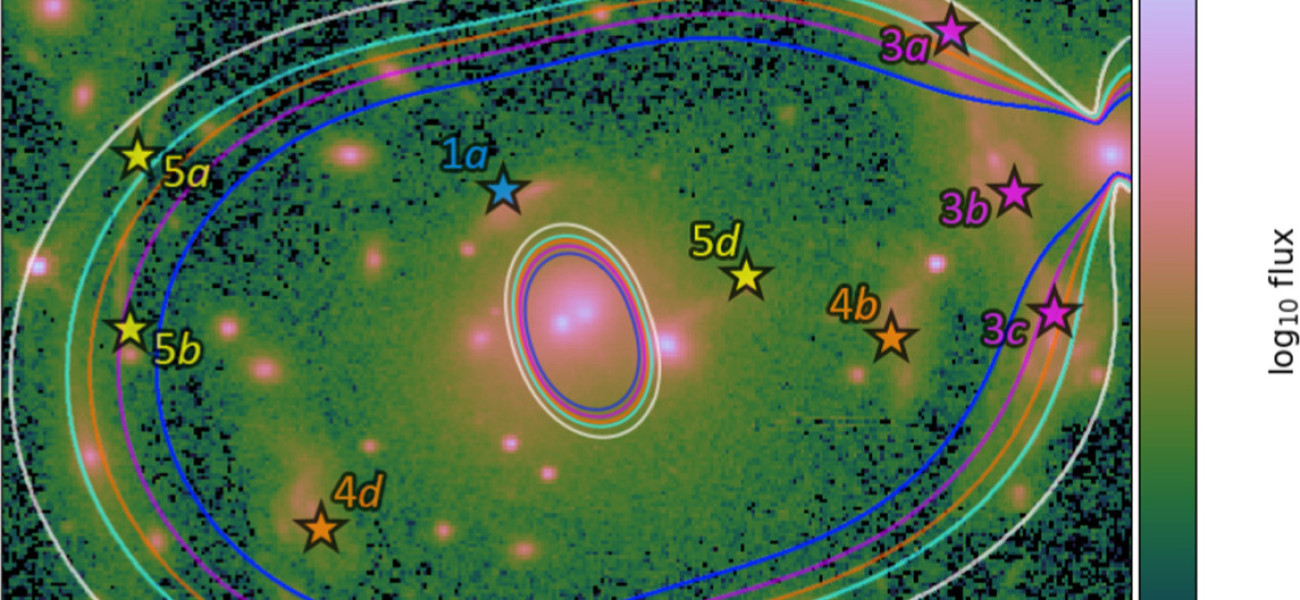
The team’s model plotted over the Hubble Space Telescope image of the Carousel Lens, predicting image locations and critical curves.
Science breakthrough
Using the Perlmutter supercomputer at the National Energy Research Scientific Computing Center (NERSC), an abundance of new data from the DESI Legacy Imaging Surveys, and recent observations from NASA’s Hubble Space Telescope, researchers from the University of California, Los Angeles, Lawrence Berkeley National Laboratory (Berkeley Lab), and collaborating institutions have identified a unique configuration of seven galaxies forming the most exquisitely aligned gravitational lens ever discovered. Named the ‘Carousel Lens,’ it offers researchers a powerful tool for exploring the Universe. The discovery was published in The Astrophysical Journal in September.
Science background
Strong gravitational lenses are rare, appearing when light traveling from far-distant space is magnified and curved by gravity as it passes through a massive object, like a cluster of galaxies. Analysis of the light distortions allows scientists to measure the properties of the cosmos, including those of dark matter and dark energy. In the Carousel Lens, distorted images from seven background galaxies were identified, including one whose four images appeared as an extremely rare “Einstein Cross” – the largest ever found. The particular alignment of the galaxies makes for a particularly symmetric cluster-scale strong lens, allowing researchers to see far into the Universe.
Science breakdown
In addition to images from the Hubble Telescope, initial spectral data for the research came from the Multi-Unit Spectroscopic Explorer (MUSE), part of the European Southern Observatory’s Very Large Telescope (VLT). The team first used Perlmutter to perform spectral data reduction—that is, focusing on the appropriate slice of data and preparing it for analysis. Comparing spectral data with the images from the telescope allowed them to better understand what they were seeing, for example, confirming via spectral comparison that four images comprising the Einstein Cross found on the telescope images were in fact of the same background galaxy.
Additionally, they used Perlmutter to produce a pixel-by-pixel model of the lens. Running the open-source Lenstronomy software package on one AMD EPYC 7713 CPU with 64 cores, the model took 11 hours to produce; ultimately, it predicted faint lensed images the research team had missed initially. They believe this pixel-level model to be the first for a cluster lens, a milestone made possible by parallel computing on Perlmutter.
Moving forward, the team is working to model this system using GIGA-Lens, a lens-modeling tool previously developed using Perlmutter, which earned its developers a NERSC Achievement Award in 2022. Because the system is so large, they are working to model it over several GPU nodes, a process accelerated by their participation in the NERSC Open Hackathon in August.
Research Lead
William Sheu
Co-authors
Aleksandar Cikota, Xiaosheng Huang, Karl Glazebrook, Christopher Storfer, Shrihan Agarwal, David J. Schlegel et al
Publication
Sheu, William, Aleksandar Cikota, Xiaosheng Huang, Karl Glazebrook, Christopher Storfer, Shrihan Agarwal, David J. Schlegel et al. "The Carousel Lens: A Well-modeled Strong Lens with Multiple Sources Spectroscopically Confirmed by VLT/MUSE." The Astrophysical Journal 973, no. 1 (2024): 3.
Funding
DOE Office of Science, Office of High Energy Physics
User Facilities
NERSC
About NERSC and Berkeley Lab
The National Energy Research Scientific Computing Center (NERSC) is the mission computing facility for the U.S. Department of Energy Office of Science, the nation’s single largest supporter of basic research in the physical sciences.
Located at Lawrence Berkeley National Laboratory (Berkeley Lab), NERSC serves 11,000 scientists at national laboratories and universities researching a wide range of problems in climate, fusion energy, materials sciences, physics, chemistry, computational biology, and other disciplines. An average of 2,000 peer-reviewed science results a year rely on NERSC resources and expertise, which has also supported the work of seven Nobel Prize-winning scientists and teams.
NERSC is a U.S. Department of Energy Office of Science User Facility.
Media contact: Email our communications team ⟶